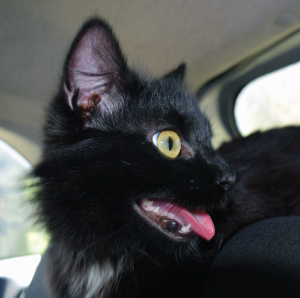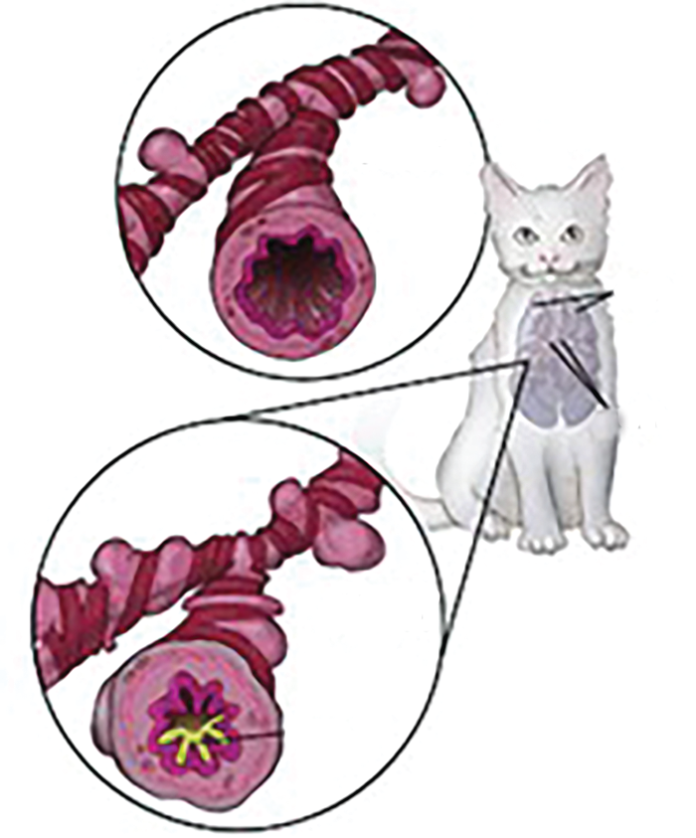As many as 5% of cats battle asthma, an allergic response that causes cats to have difficulty breathing. Its onset is usually gradual. The immune systems of affected cats respond to airborne allergens such as smoke, pollen, or dust mites by making antibodies against them, and when they are exposed again, these antibodies initiate an inflammatory response that can be severe enough to be life-threatening.
Most asthmatic cats are diagnosed between 3 to 6 years of age. At one time, Siamese cats were considered high risk, but this belief has not held up to the test of time. Overweight cats may be predisposed to asthma.
Dr. Betsy Arnold, DVM (Cornell, 1980), has expertise with feline asthma, both as a veterinarian and a breeder of Siamese cats. She recommends that you have your cat examined by your veterinarian if you notice any respiratory problems, and radiographs may be obtained to evaluate her lungs. Other respiratory illnesses, such as pneumonia or cancer, need to be ruled out.
How Asthma Develops
Realistically, it is impossible to protect your cat from all the allergens that cause her to have an asthmatic attack. You can stop smoking, if you smoke, and avoid using a wood stove or fireplace, but you can’t keep her life free from dust mites, pollen, and other triggers.
When your cat is exposed to the allergen, the immune system begins its response and inflammation sets in. The airways become irritated and constrict in response, while the inflamed tissues swell. Usually, mucus is produced in response to the irritation, further decreasing the size of the airway. The lower airways, the bronchi and bronchioles, are affected the most (a veterinarian may call this condition “bronchitis”). Your cat may start to have trouble breathing, especially when she exhales, and wheezing and coughing may be observed. The cough is generally a dry, hacking cough that sounds a lot like the one that precedes a hairball being coughed up.
Cats with mild symptoms of asthma may only show signs at certain times of year, such as when pollen counts are high. If symptoms become moderate or severe, you may notice your cat is also less active. She may breathe with her mouth open and appear to take rapid, shallow breaths, as if panting. As the symptoms worsen, your cat may expend a great deal of energy just to breathe. You may notice some weight loss, and it will become apparent that your cat is in some distress.
What You Should Know
A severe asthma attack is a veterinary emergency.
If you notice these signs, calmly put your cat in a carrier in preparation for an immediate trip to the veterinarian and call ahead to let them know you’re arriving:
- Labored breathing (mouth open, neck extended)
- Gums are pale or bluish, rather than pink
Cats experiencing a severe attack may need supplemental oxygen and injectable medications to rapidly reduce inflammation and dilate airways as well as a sedative, in many cases, to reduce their stress from being unable to fully oxygenate.

Furiarossa | Shutterstock Photo
Diagnosis
Your veterinarian will listen to your cat’s lungs and chest for abnormal sounds like wheezes or crackles.
He or she may obtain radiographs. Asthmatic feline lungs often appear overinflated, as the cat works hard to move air in and out. The radiographs may reveal a characteristic pattern along the airways that is created by the accumulation of inflammatory cells (called a bronchiolar pattern).
Your veterinarian may opt to do a tracheal lavage, which allows him or her to look for unusual cells or pathogens in the trachea. Your cat will need to be sedated for this procedure, which involves placing a thin catheter into the trachea and upper bronchi and injecting a small amount of sterile saline. The saline is then retrieved for evaluation.
The gold standard for diagnosis is is bronchoscopy, during which a small flexible camera is inserted into the airways to evaluate the lining and diameter of the airways and to collect cell samples for evaluation. This procedure requires either anesthesia or heavy sedation and is often performed only at specialty clinics.
Your veterinarian will check for heartworm disease and lungworms, which can cause similar clinical signs. Bloodwork may show an increase in eosinophils, which are disease-fighting white blood cells that can be associated with allergies and parasitic infections.
Training For Inhaler Acceptance
With patience, many cats can be trained to use an inhaler mask. Start by getting your cat used to being gently held or simply staying put on a mat while you hold her. Have plenty of treats ready!
Show your cat the inhaler, placing a treat in the canister at first for her to play with. Move the mask closer and closer to her nose, each time adding a treat for her to get.
When you the put the inhaler together and give a puff, it may startle your cat. Speak gently while engaging the inhaler to reduce its sound. Reward immediately. At first, you may be lucky if your cat takes one breath in the mask, but with patience many cats will stay with their heads in the mask for a full treatment.
It is important to note that this whole training sequence may take days or weeks. Don’t rush it. Slow and steady works better than frightening your cat.
If your cat has asthmatic attacks during the training period, discuss other options to use while you’re training with your veterinarian.
Treatment
Any bacterial infections found in retrieved fluid samples will be treated with antibiotics.
For asthma, the mainstay drug is a corticosteroid, such as prednisolone or fluticasone, to reduce inflammation. The ideal way to give steroids is via an inhaler, and, yes, there are ones made specifically for cats.
With aerosol therapy, the steroid dose goes directly to the respiratory tract where it is needed. This treatment has a lower risk of side effects, such as diabetes mellitus, from long-term systemic steroid use. Your cat may need to be trained to handle the mask using treats and a lot of patience. Inhalers can be quite expensive, but they can be very effective (see sidebar, below, and go to tinyurl.com/felineinhaler for a video showing how to use an inhaler for cats).
Some cats simply do not accept the inhaler mask, says Dr. Arnold. For these cats, your options include an injectable steroid, daily pills, liquids, or formulated transdermal medications. With the transdermal option, the medicine is applied to the inner ear flap, where it is absorbed through the skin. All these methods of delivering systemic steroids carry a risk of side effects.
Bronchodilators such as albuterol can open airways in acute attacks. These medications relax the muscles around airways, opening the bronchi to allow increased air flow. Theophylline is often used for long-term management.
Treatments on the horizon are fatty acid supplements, immunotherapy for allergens, and stem-cell therapy, but more research is needed before they are widely used. Some may now be worth a try, however, such as fatty acids in the form of fish oil added to your cat’s diet.
Asthma is not curable. Treatment can slow its progression and control symptoms so that your cat can lead a more comfortable life.
Some cats will only need seasonal treatment, while others need year-round therapy, possibly varying how much medication or which medications are given at any given time. Cats with severe asthma may require occasional veterinary hospital stays.
What You Can Do
- Switch to a dust free cat litter.
- Minimize or avoid household sprays for cleaning, odor reduction, air freshening, hair spray, and so on. If you must use these items, have a safe room where your cat can stay until the aerosol clears.
- Do not allow anyone to smoke in your house.
- Get rid of carpets, if possible.
- Become a dedicated house cleaner, vacuuming, dusting, and mopping frequently. Wash drapes and furniture covers regularly.
- Install HEPA filters on vacuums and furnaces, if possible. HEPA air filters can help in individual rooms.
- If your cat is overweight, discuss ways to help her lose weight with your veterinarian.




